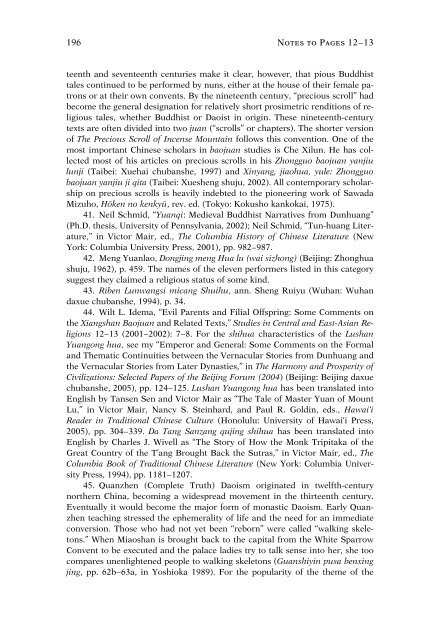Two Precious Scroll Narratives of Guanyin and Her ... - Khamkoo
Two Precious Scroll Narratives of Guanyin and Her ... - Khamkoo
Two Precious Scroll Narratives of Guanyin and Her ... - Khamkoo
You also want an ePaper? Increase the reach of your titles
YUMPU automatically turns print PDFs into web optimized ePapers that Google loves.
196 Notes to Pages 12–13<br />
teenth <strong>and</strong> seventeenth centuries make it clear, however, that pious Buddhist<br />
tales continued to be performed by nuns, either at the house <strong>of</strong> their female patrons<br />
or at their own convents. By the nineteenth century, ‘‘precious scroll’’ had<br />
become the general designation for relatively short prosimetric renditions <strong>of</strong> religious<br />
tales, whether Buddhist or Daoist in origin. These nineteenth-century<br />
texts are <strong>of</strong>ten divided into two juan (‘‘scrolls’’ or chapters). The shorter version<br />
<strong>of</strong> The <strong>Precious</strong> <strong>Scroll</strong> <strong>of</strong> Incense Mountain follows this convention. One <strong>of</strong> the<br />
most important Chinese scholars in baojuan studies is Che Xilun. He has collected<br />
most <strong>of</strong> his articles on precious scrolls in his Zhongguo baojuan yanjiu<br />
lunji (Taibei: Xuehai chubanshe, 1997) <strong>and</strong> Xinyang, jiaohua, yule: Zhongguo<br />
baojuan yanjiu ji qita (Taibei: Xuesheng shuju, 2002). All contemporary scholarship<br />
on precious scrolls is heavily indebted to the pioneering work <strong>of</strong> Sawada<br />
Mizuho, Hōken no kenkyū, rev. ed. (Tokyo: Kokusho kankokai, 1975).<br />
41. Neil Schmid, ‘‘Yuanqi: Medieval Buddhist <strong>Narratives</strong> from Dunhuang’’<br />
(Ph.D. thesis, University <strong>of</strong> Pennsylvania, 2002); Neil Schmid, ‘‘Tun-huang Literature,’’<br />
in Victor Mair, ed., The Columbia History <strong>of</strong> Chinese Literature (New<br />
York: Columbia University Press, 2001), pp. 982–987.<br />
42. Meng Yuanlao, Dongjing meng Hua lu (wai sizhong) (Beijing: Zhonghua<br />
shuju, 1962), p. 459. The names <strong>of</strong> the eleven performers listed in this category<br />
suggest they claimed a religious status <strong>of</strong> some kind.<br />
43. Riben Lunwangsi micang Shuihu, ann. Sheng Ruiyu (Wuhan: Wuhan<br />
daxue chubanshe, 1994), p. 34.<br />
44. Wilt L. Idema, ‘‘Evil Parents <strong>and</strong> Filial Offspring: Some Comments on<br />
the Xiangshan Baojuan <strong>and</strong> Related Texts,’’ Studies in Central <strong>and</strong> East-Asian Religions<br />
12–13 (2001–2002): 7–8. For the shihua characteristics <strong>of</strong> the Lushan<br />
Yuangong hua, see my ‘‘Emperor <strong>and</strong> General: Some Comments on the Formal<br />
<strong>and</strong> Thematic Continuities between the Vernacular Stories from Dunhuang <strong>and</strong><br />
the Vernacular Stories from Later Dynasties,’’ in The Harmony <strong>and</strong> Prosperity <strong>of</strong><br />
Civilizations: Selected Papers <strong>of</strong> the Beijing Forum (2004) (Beijing: Beijing daxue<br />
chubanshe, 2005), pp. 124–125. Lushan Yuangong hua has been translated into<br />
English by Tansen Sen <strong>and</strong> Victor Mair as ‘‘The Tale <strong>of</strong> Master Yuan <strong>of</strong> Mount<br />
Lu,’’ in Victor Mair, Nancy S. Steinhard, <strong>and</strong> Paul R. Goldin, eds., Hawai‘i<br />
Reader in Traditional Chinese Culture (Honolulu: University <strong>of</strong> Hawai‘i Press,<br />
2005), pp. 304–339. Da Tang Sanzang qujing shihua has been translated into<br />
English by Charles J. Wivell as ‘‘The Story <strong>of</strong> How the Monk Tripitaka <strong>of</strong> the<br />
Great Country <strong>of</strong> the T’ang Brought Back the Sutras,’’ in Victor Mair, ed., The<br />
Columbia Book <strong>of</strong> Traditional Chinese Literature (New York: Columbia University<br />
Press, 1994), pp. 1181–1207.<br />
45. Quanzhen (Complete Truth) Daoism originated in twelfth-century<br />
northern China, becoming a widespread movement in the thirteenth century.<br />
Eventually it would become the major form <strong>of</strong> monastic Daoism. Early Quanzhen<br />
teaching stressed the ephemerality <strong>of</strong> life <strong>and</strong> the need for an immediate<br />
conversion. Those who had not yet been ‘‘reborn’’ were called ‘‘walking skeletons.’’<br />
When Miaoshan is brought back to the capital from the White Sparrow<br />
Convent to be executed <strong>and</strong> the palace ladies try to talk sense into her, she too<br />
compares unenlightened people to walking skeletons (Guanshiyin pusa benxing<br />
jing, pp. 62b–63a, in Yoshioka 1989). For the popularity <strong>of</strong> the theme <strong>of</strong> the

















